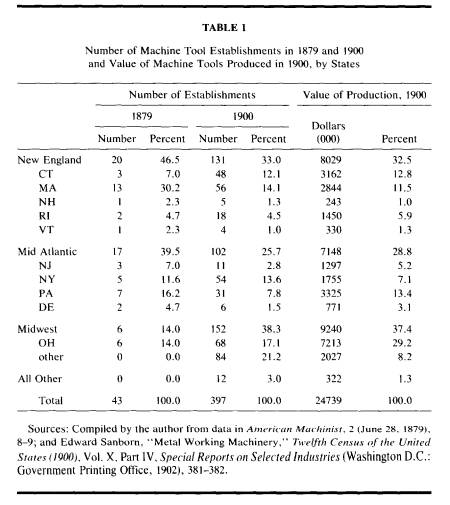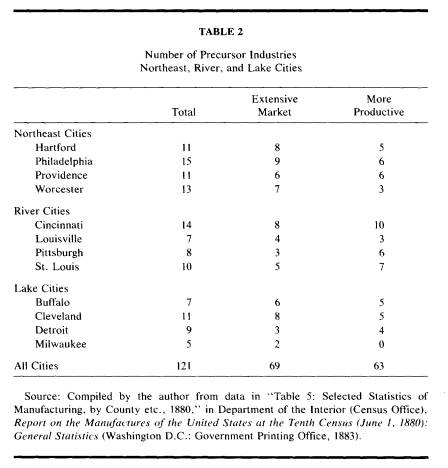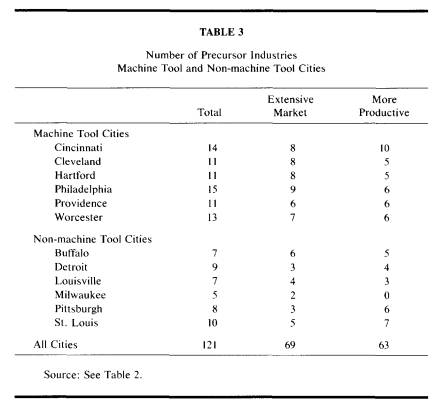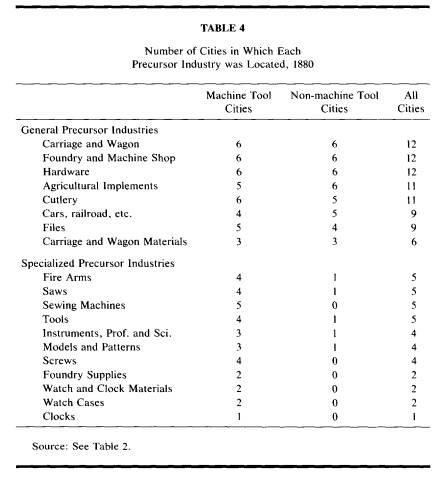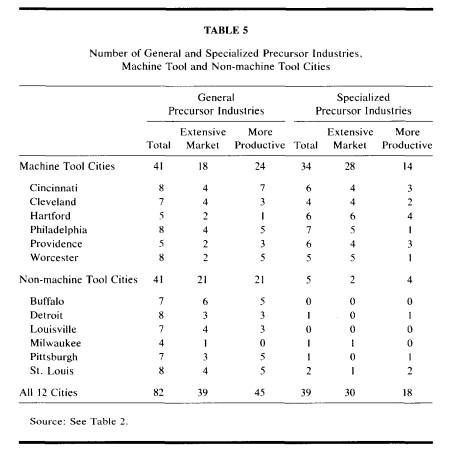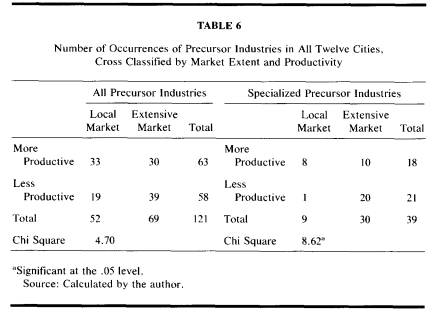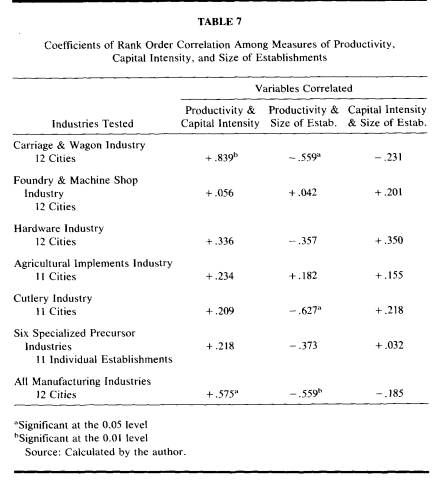Ohio History Journal
- 1
- 2
- 3
- 4
- 5
- 6
- 7
- 8
- 9
- 10
- 11
- 12
- 13
- 14
- 15
- 16
JON GLASGOW
The Westward Expansion
of the Manufacturing
Belt: The Ohio Machine Tool
Industry in
the Late
Nineteenth Century
For more than sixty years the
Manufacturing Belt has been recog-
nized as an important feature of the
human geography of the United
States. Early studies, mostly by
geographers,1 delimited the current
areal extent of the region-roughly a
quadrilateral with corners at St.
Louis, Minneapolis, Portland (Maine),
and Richmond. Later, attention
shifted from description to explanation
as geographers were joined by
scholars from other disciplines who were
also interested in finding
answers to questions about the
locational aspects of the Manufacturing
Belt.2 Why did it originate
in New England rather than elsewhere?
Jon Glasgow is Associate Professor of
Geography at The College at New Paltz, State
University of New York.
1. Sten DeGeer, "The American
Manufacturing Belt," Georgrafiska Annaler, 9
(1927), 233-359; Richard Hartshore,
"A New Map of the Manufacturing Belt of
North
America," Economic Geography, 12
(1936), 45-53; Clarence Jones, "Areal Distribution
of Manufacturing in the United States, Economic
Geography, 14 (1938), 217-22; Alfred
Wright, "Manufacturing Districts of
the United States," Economic Geography, 14
(1938), 195-200.
2. Robert Aduddell and Louis Cain,
"Location and Collusion in the Meat Packing
Industry," in Business
Enterprise and Economic Change, ed. by Louis Cain and Paul
Uselding (Kent, Ohio, 1973), 85-117;
Fred Bateman and Thomas Weiss, "Comparative
Regional Development in Antebellum
Manufacturing," The Journal of Economic
History, 35 (1975), 182-208; John Borchert, "America's
Changing Metropolitan Re-
gions," Annals of the
Association of American Geographers, 62 (1972), 352-73; Andrew
Burghardt, "A Hypothesis About
Gateway Cities," Annals of the Association of
American Geographers, 61 (1971), 269-85; Edward Duggan, "Machines,
Markets, and
Labor: The Carriage and Wagon Industry
in Late-Nineteenth Century Cincinnati,"
Business History Review, 51 (1977), 308-25; Irwin Feller, "The Diffusion
and Location
of Technological Change in the American
Cotton-Textile Industry, 1890-1970," Tech-
nology and Culture, 15 (1974), 569-93; Jean Gottman, Megalopolis: The
Urbanized
Northeastern Seaboard of the United
States (Cambridge, Mass., 1961); David
Meyer,
20 OHIO
HISTORY
Why it expanded westward as far as St.
Louis and Minneapolis but no
further? Why did it become internally
differentiated with particular
cities specializing in the manufacture
of some products rather than
other ones? With the decline of the
dominance of the Manufacturing
Belt, recent works have offered
prescriptions for retaining existing
industries and for attracting new ones,
or policies to ameliorate the ill
effects of industrial decline.3 However,
the task of explanation is not
complete; for some important events
involved in the extension of the
Manufacturing Belt across the
Appalachians into the Midwest remain
to be explained. One such event is the
emergence, between 1880 and
1900, of a trans-Appalachian machine
tool industry centered in Ohio
(Table 1). This coincided with the first
appearance of firms that
specialized in the production of machine
tools and with advances in
machine tool technology that were
prerequisities for the later develop-
ment of assembly line production of
automobiles.4 Without the pres-
ence of nearby and innovative machine
tool producers, it would have
been difficult for turn-of-the-century
automobile firms of the Midwest
to challenge those of New England for
supremacy in the national
market, and the subsequent geographical
evolution of the Manufactur-
ing Belt might have been very different.
The premise of this paper is that the
development of machine tool
production in Ohio was a manifestation
of the Industrial Frontier
Hypothesis. In a previous study of the
time and place of origin of three
manufacturing industries,5 it
was shown that in each case: (1) crucial
financial backing had been provided by local
entrepreneurs who
"Emergence of the American
Manufacturing Belt: An Interpretation," Journal of
Historical Geography, 9 (1983), 145-74; Allan Pred, The Spatial Dynamics of
U.S.
Urban Industrial Growth, 1800-1914;
Interpretive and Theoretical Essays (Cambridge,
Mass., 1966): Mary Beth Pudup,
"From Farm to Factory: Structuring and Location of
the U.S. Farm Machinery Industry," Ecomonic
Geography, 63 (1987), 203-22; David
Ward, Cities and Immigrants: A
Geography of Change in Nineteeth Century America
(New York, 1971).
3. Barry Bluestone and Bennett Harrison,
The Deindustrialization of America (New
York, 1982); Ann Markusen, Regions:
The Economics and Polities of Territory (Totowa,
NJ, 1987): Richard Peet, "Relations
of Production and the Relocation of United States
Manufacturing Industry Since 1960,"
Economic Geography, 59 (1983), 11243; Neil
Smith and Ward Dennis, "The
Restructuring of Geographical Scale: Coalescence and
Fragmentation of the Northern Core
Region," Economic Geography, 63 (1987), 160-82.
4. Victor S. Clark, History of
Manufactures in the United States. Vol. IlI,
1893-1928 (New York, 1929), 153; Frederick Geier, The Coming
of the Machine Tool
Age: The Tool Builders of Cincinnati (New York, 1949), 11; Joseph Roe, English and
American Tool Builders (New Haven, 1916), 261; Nathan Rosenberg,
"Technological
Change in the Machine Tool Industry,
1840-1910," The Journal of Economic History, 23
(1963), 414-43.
5. Jon Glasgow, "Innovation on the
Frontier of the American Manufacturing Belt,"
Pennsylvania History, 52 (1985), 1-21.
|
Westward Expansion of the Manufacturing Belt 21 |
|
|
|
needed new investment opportunities to maintain the small fortunes that they had made in frontier extractive industries that were threat- ened by resource depletion; and (2) that essential technical expertise had been contributed by migrants to the newly industrializing centers from older eastern centers. These previously studied innovations on the Industrial Frontier were the anthracite-fueled iron industry of Bethlehem (Pennsylvania) in the 1840s, the Bessemer process steel industry in Pittsburgh in the 1870s, and the assembly line production of automobiles in Detroit in the 1910s. The emergence between 1880 and 1900 of the machine tool industry in Ohio fits into this historical- |
22 OHIO HISTORY
geographical sequence and is, therefore,
consistent with the idea of a
westward moving Industrial Frontier
within which conditions were
especially favorable for industrial
innovation. Two other pertinent
concepts are David Meyer's idea of
"Replicated Systems"6 to under-
stand the development of
trans-Appalachian manufacturing in general,
and George Wing's "Steamboat
Theory"7 to explain the development
of machine tool production in Cincinnati
in particular. Wing maintains
that skilled labor was critical in
explaining the growth of the machine
tool industry, and that Cincinnati had a
surplus of skilled machinists in
the 1890s because the recent decline of
the local steamboat manufac-
turing industry meant that "...
individuals who had received their
training in the old industry had to seek
other avenues for their
talents."8 This
interpretation is plausible for Cincinnati, but it does not
explain why the other major
trans-Appalachian centers of steamboat
production-Pittsburgh, Louisville, and
St. Louis-did not develop
into rival centers of machine tool
production.
According to Meyer, the major industrial
cities of the Midwest
originated as producers of manufactured
products for relatively self-
sufficient market regions which he
called "replicated systems."9 All
such regions had similar demands for
manufactured products; there-
fore, each nascent regional center had
about the same mix of manu-
facturing industries, including
producers of machine tools. Differences
in industrial structure among these
cities began to develop in the 1850s
and 1860s as individual firms in
particular cities took advantage of
declining freight rates and increasing
scale economies in production to
capture multi-regional and even national
markets.
Each industrial system [i.e. market
region] was a potential location for a new
industry. Its location depended on ties
to existing multiregional/national
industries that conveyed advantages to
some industrial systems and on a
random location of inventors and
innovators ... .10
The Wing and Meyer interpretations have
interesting parallels with
and differences from the Industrial
Frontier Hypothesis. As in the
Industrial Frontier Hypothesis, Wing
proposes that the decline of an
established industry, by releasing
resources that are not readily avail-
6. Meyer, "American Manufacturing
Belt."
7. George Wing, "The History of the
Cincinnati Machine-Tool Industry," (unpub-
lished D.B.A. dissertation, Indiana
University, 1964).
8. Ibid., 44, 59-60. See also Clark, Manufactures
in the United States, Vol. II, 360;
and Roe, Tool Builders, 266-67.
9. Meyer, "American Manufacturing
Belt."
10. Ibid.. 161.
Westward Expansion of the
Manufacturing Belt
23
able elsewhere, can provide an advantage
for attracting new industries
to a region. A significant difference is
that Wing specified skilled labor
released from the demise of an obsolete
manufacturing industry rather
than capital and entrepreneurship driven
out of primary industries by
the depletion of natural resources.
Although Meyer's interpretation
and that of the Industrial Frontier both
recognize the importance of the
location of invention and innovation in
explaining the location of
manufacturing industry, Meyer describes
innovators and inventors as
having been randomly distributed among
places. Contrarily, the idea of
an Industrial Frontier connotes that
innovators and inventors, along
with skilled laborers and entrepreneurs,
migrated to the Industrial
Frontier in sufficient numbers to create
a region that was especially
conducive to the creation of new
manufacturing industries.
Combining the ideas of Meyer and Wing
with that of the Industrial
Frontier provides the following
plausible, but as yet unsubstantiated,
explanation for the emergence of the
Ohio machine tool industry. The
first machine tools produced in the
United States were made as a
sideline by Philadelphia and New England
firms that needed machine
tools themselves to manufacture products
such a textile machinery,
firearms, and locomotives. Some of the
more innovative of these firms
capitalized on the expanding market for
their sideline by shifting to
machine tools as their major
product." As demand for manufactured
products increased in the
trans-Appalachian west, Meyer's "replicated
systems" emerged including firms
that would evolve into machine tool
producers by the same process. Then,
just as critical advances were
being made in machine tool technology,
conditions conducive to
industrial innovation spread westward
with the Industrial Frontier into
Ohio, accounting for its rise to first
place in machine tool production.
Following Wing's idea, Cincinnati became
the leading city in machine
tool production, surpassing rival Ohio
industrial center Cleveland,
because of the special advantage of
skilled labor released by the
cessation of steamboat production in
Cincinnati.
11. Thomas Cochran, Frontiers of
Change: Early Industrialization in America (New
York, 1981), 61; George Gibb, The
Sacco-Lowell Shops: Textile Machinery Building in
New England 1813-1944 (New York, 1969), 179; Guy Hubbard, "The Machine
Tool
Industry," in The Development of
American Industries: Their Economic Significance ed.
by John Glover and William Bouck (New
York, 1933), 510-19; Roe, English and
American Tool Builders, 114-20; Nathan Rosenberg, Technology and American
Eco-
nomic Growth (New York, 1972), 99; Merritt Smith, "John Hall,
Simeon North, and the
Milling Machine: The Nature of
Innovation among Antebellum Arms Makers," Tech-
nology and Culture, 14 (1973), 573-91; W. Paul Strassman, Risk and
Technological
Innovation: American Manufacturing
Methods during the Nineteenth Century (Ithaca,
N.Y., 1959), 117-30; Robert Woodbury, Studies
in the History of Machine Tools
(Cambridge, Mass., 1972).
24 OHIO HISTORY
Perhaps the most conjectural part of the
above explanation is the
assertion that, as early as 1880,
conditions in Ohio were unusually
favorable for the establishment of firms
specializing in the production
of machine tools for national markets.
This study provides evidence
that such favorable conditions did
exist, as indicated by the concen-
tration in Ohio of what are hereafter
referred to as Precursor Indus-
tries-industries presumed to have been
strongly linked to machine
tool production and which provided the
preconditions for the develop-
ment of a machine tool industry with a
national market.
Eighteen-eighty has been selected as the
appropriate year for this
study, for the following reasons.
Consistent with the idea of an
Industrial Frontier, 1880 has been
identified as the year in which
Skilled mechanics in the workshops of
New England and Philadelphia ...
began to cross the Alleghenies in
increasing numbers. Settling in ... Cincin-
nati, Cleveland, and Hamilton [a
satellite of Cincinnati] they prospered so well
that Cincinnati . . . ultimately ousted
Philadelphia to become the machine-tool
making capital of America.12
Furthermore, 1880 has been described as
".. a significant bench-
mark ... in terms of technical
innovation leading to mass production
...;"13 the year in which " ... a group of firms whose
principle product
was machine tools ..." first
appeared;14 and as the initial year in a
three-decade era "... characterized
by an immense increase in the
,,15
development of machine tools for highly
specialized purposes ...."15
From the 332 industries for which data
are published in the 1880
Census of Manufacturing,16 twenty-two
were identified as being pre-
cursors of the machine tool industry.
Nine of these were described in
Fitch's seminal 1880 census monograph17
as being either industries that
required automatic or precision metal
working, or used interchange-
able parts: agricultural implements,
ammunition, clocks, cutlery and
edge tools, firearms, hardware, railroad
and street cars, sewing ma-
chines, and watches. Seven industries
were added because of their
apparent similarity to, or relationship
with, the first nine: watch cases,
12. Lionell Rolt, A Short History of
Machine Tools (Cambridge, Mass., 1965), 176.
13. John James, "Structural Change
in American Manufacturing, 1850-1890," The
Journal of Economic History, 43 (1983), 440.
14. Ross Robertson, Changing
Production of Metalworking Machinery: 1860-1920,
Studies in Income and Wealth, Vol. 30
(New York, 1966), 484.
15. Rosenberg, "Technological
Change," 433.
16. Department of the Interior (Census
Office), Report on the Manufactures of the
United States at the Tenth Census:
(June 1, 1880): General Statistics (Washington
D.C.,
1883), "Table II: The United States
by Specified Industries," 19-24.
17. Charles Fitch, "Report on the
Manufactures of Interchangeable Mechanism," in
Department of the Interior, Manufactures
of the United States, 1880.
|
Westward Expansion of the Manufacturing Belt 25 |
|
|
|
clock cases, watch and clock materials, files, saws, screws, and tools. Six additional industries were included for the following reasons: the carriage and wagon industry and the carriage and wagon materials industry because the former has been proposed as being one of the first industries in which power machinery was efficiently used to manufac- ture a complex product;18 the models and patterns industry because it supplied a vital service to machine tool producers; the professional and scientific instruments industry as one that required precise machining of metal parts; the foundry and machine shop industry because it included the few firms that specialized in machine tool production in
18. Duggan, "Machines, Markets, and Labor," 309. |
26 OHIO
HISTORY
1880; and the foundry supply industry
for its presumed connection to
the foundry and machine shop industry.
Data pertaining to nineteen Precursor
Industries19 were compiled for
Cincinnati, Cleveland and ten other
cities20 selected to create three
groups of four cities each (Table 2).
The Northeast group consists of
the four cities that ranked second
through fifth, after Cincinnati, in
machine tool production in 1900.21
Cincinnati and the three other major
trans-Appalachian centers of steamboat
production constitute the
group of River Cities.22 The
Lake Cities include Cleveland and the
three other cities on the Great Lakes
that had, in 1880, numbers of
manufacturing employees most similar to
the number employed in
Cleveland.23
It is reasonable to assume that the most
favorable conditions for the
development of machine tool production
were in those cities with labor
forces possessing the greatest variety
of skills and expertise in Precur-
sor Industries as measured, initially,
by the total number of Precursor
Industries found in a city (Table 2,
column 1). Note that by this
measure Cincinnati and Cleveland each
rank first in their respective
groups and that their numbers are within
the range of the cities of the
Northeast group. Since a Precursor
Industry in a city may have
consisted of only one small and
inefficient firm with a market limited to
that city, the numbers listed in column
1 of Table 2 may be misleading.
Therefore, an attempt was made to
identify cities in which Precursor
Industries served larger than local
markets and cities in which Precur-
sor Industries were unusually
productive. In a city in which a Precur-
sor Industry's percentage of the local
manufacturing labor force
exceeded that industry's percentage of
the national labor force (i.e.,
cities in which the location quotient24
for that industry exceeded 1.0),
19. Three of the twenty-two Precursor
Industries (ammunition, clock cases, and
watches) were not found in any of the
cities examined in this study.
20. Although the more familiar city
names are used throughout this study, the data are
for the counties in which the cities are
located. County data were preferred to city data
(both were available in the 1880 Census
of Manufacturing) so that factories located just
beyond the corporate limits of cities
would be included in the study.
21. Edward Sanborn, "Metal-Working
Machinery," in U.S. Census of Manufactur-
ing 1900, Vol. X., Part IV, Special Reports on Selected
Industries (Washington, D.C.,
1902), 385.
22. Louis Hunter, Steamboats on the
Western Rivers: An Economic and Technolog-
ical History (New York, 1969) 105-07.
23. Francis Walker, "Remarks on the
Statistics of Manufactures," in Department of
the Interior, Manufactures of the
United States, 1880: General Statistics, xxiv-xxv. The
appropriate data are Cleveland 21,724;
Milwaukee 20,886; Buffalo 18,021; and Detroit
16,110.
24. The location quotient is a commonly
used measure of the extent to which
phenomena are concentrated in particular
places. See, for example, George Schnell and
|
Westward Expansion of the Manufacturing Belt 27 |
|
|
|
that industry was presumed to have a market that extended beyond the city. Such industries are listed as Extensive Market Precursor Indus- tries in the second column of Table 2. As in the first column of Table 2, Cincinnati and Cleveland rank first in their group and have numbers that are comparable to the cities of the Northeast. A city in which the value added per employee in a Precursor Industry exceeded the national average in the industry was deemed to have a More Productive Precursor Industry (Table 2, column 3),25 ostensibly the result of that city having more tractable or more highly skilled labor, or of firms in that city having introduced more highly mechanized processes. The
Mark Monmonier, The Study of Population: Elements, Patterns and Processes (Colum- bus, 1983), 28-29. 25. Value added was computed by subtracting the "Value of materials" from the "Value of products" listed in "Table V-Selected Statistics of Manufactures by Counties, 1880," in Department of the Interior, Manufactures of the United States, 1880. |
28 OHIO HISTORY
numbers in the third column of Table 2
do not follow the pattern that
appears in the first two columns.
However, it is worth noting that Cin-
cinnati ranks first in this column, and
a close second in the other two.
In general, the data arrayed in Table 2
show that Cincinnati and
Cleveland had numbers of Precursor
Industries comparable to the
major machine tool centers of the
Northeast, and distinctly higher
numbers than the other cities in the
"River" and "Lake" Groups. The
validity of this generalization becomes
more apparent by examining
Table 3 in which Cincinnati and
Cleveland have been merged with the
Northeast to form a group of six Machine
Tool Cities, leaving the
remaining three River Cities and three
Lake Cities to be combined into
a group of six Non-machine Tool Cities.
Note that this regrouping of
cities precisely discriminates between
cities with higher and lower
numbers of Total Precursor Industries
(Table 3, column 1), and misses
by only one city (Buffalo) in
discriminating between cities with higher
and lower numbers of Extensive Market
Precursor Industries (Table 3,
column 2). Except for Cincinnati,
however, the Machine Tool Cities do
not appear to be significantly different
from the Non-machine Tool
Cities in numbers of More Productive
Precursor Industries (Table 3,
column 3). This somewhat unexpected
outcome with respect to the
More Productive Precursor Industries led
to the following refinement
in classifying Precursor Industries
(Table 4).
Table 4 shows the Precursor Industries
arranged in descending order
by the number of sample cities in which
each occurred in 1880. Since
they were found with equal frequency in
Machine Tool and Non-
machine Tool Cities, the first eight
industries are called General Pre-
cursor Industries. The other eleven
industries, each found in less than
half of the sampled cities, are located almost
exclusively in Machine
Tool cities. Evidently, these eleven
Specialized Precursor Industries
had demanding labor, technology or
market requirements that were
found in only a limited number of
manufacturing centers in 1880.
Machine Tool and Non-machine Tool cities
are nearly identical with
respect to numbers of General Precursor
Industries (Table 5). In the
aggregate, each group has exactly the
same total number (41), very
nearly the same number with Extensive
Markets (18 and 21), and very
nearly the same number of More
Productive ones (24 and 21).
Likewise, examining the numbers of
General Precursor Industries
listed for individual cities in Table 5
reveals only slight differences
between the two groups of cities. The
total numbers range from 5 to 8
for Machine Tool cities and from 4 to 8
for Non-machine Tool cities;
the number with extensive markets range
from 2 to 4 and from I to 6
respectively; and the number of More
Productive, General Precursor
Industries ranges from 1 to 7 for
Machine Tool Cities and from 0 to 5
|
Westward Expansion of the Manufacturing Belt 29 |
|
|
|
for Non-machine Tool Cities. Evidently, the presence of these General Precursor Industries did not assure that a city would develop into a major center of machine tool production. In contrast, the Specialized Precursor Industry section of Table 5 displays unequivocable differences between the two groups of cities with totals ranging from 4 to 6 among the Machine Tool cities and from 0 to 2 among the Non-machine Tool cities (Table 5, column 4). The clearest distinction between Machine Tool and Non-machine Tool cities-and the most convincing evidence in support of the premise of this study-is found in the fifth column of Table 5: Specialized Precursor Industries with Extensive Markets were almost nonexistent |
|
30 OHIO HISTORY |
|
|
|
in the Non-machine Tool group of cities, one each in St. Louis and Milwaukee and none in the other four, while every one of the Machine Tool cities had a least four of these industries. These data offer the sought for evidence that preconditions for the development of firms producing special purpose machine tools for the national market had, by 1880, extended across the Appalachians to Cincinnati and Cleve- land, but not to other River and Lake cities. Before concluding, however, some further comments about the More Productive Precur- sor Industries are in order. As can be seen from comparing the third and sixth columns of Table 5, separating Specialized from General Precursor Industries enhances the contrast between Machine Tool and Non-machine Tool cities with respect to number of More Productive Precursor Industries. Fourteen |
|
Westward Expansion of the Manufacturing Belt 31 |
|
|
|
of eighteen Specialized, More Productive industries were in Machine Tool cities, whereas the number of General, More Productive indus- tries is almost evenly divided between the two groups of cities (24 and 21). Nevertheless, the More Productive Precursor Industries still pose some interesting problems. For example, a higher proportion of General Precursor Industries than Specialized Precursor Industries were identified as being More Productive (45 of 82 compared to 18 of 39). Furthermore (Table 6), nearly two-thirds (33 of 52) of the Local Market industries were in the More Productive category, yet fewer than half (30 of 69) of the Extensive Market Precursor Industries were identified as More Productive. This apparently negative relationship between productivity and extent of market becomes stronger when the comparison is limited to the Specialized Precursor Industries: 10 of 30 Extensive Market compared to 8 of 9 Local Market classified as More Productive. Indications that General Precursor Industries were more productive than Specialized ones and that Precursor Industries in the Non-machine Tool cities were more productive than those in the Machine Tool cities are unexpected. It could be that Specialized Precursor Industries in Machine Tool cities consisted of unusually large proportions of very young firms that had just begun to develop from small, labor intensive, local market firms with low ratios of value |
|
32 OHIO HISTORY |
|
|
|
added per worker hour into firms that were larger and more capital intensive, with more extensive markets and more productive labor forces. This notion cannot be verified within the scope of the present paper, but Table 7 does report the result of some tests of rank-order correlations among measures of labor productivity (value added per employee), capital intensity (capital invested per employee), and size of establishment (number of employees per establishment). The first five tests use data from the five Precursor Industries that were found in at least eleven of the sampled cities. Of necessity, all of these are General Precursor Industries. In order to include analysis of Special- |
Westward Expansion of the
Manufacturing Belt 33
ized Precursor Industries, none of which
occurred in enough cities to
permit valid rank-order correlation of
within-industry relationships, the
sixth test used data for eleven
individual firms distributed among six
separate Specialized Precursor
Industries in seven different cities-the
six Machine Tool cities plus Milwaukee.
These are the eleven cases in
which a specialized Precursor Industry
was represented in a city by a
single establishment.26 The
seventh test includes data from all twelve
of the sample cities for all
manufacturing industry in the aggregate, not
limited to Precursor Industries. As
expected, all coefficients between
value added per employee and capital
intensity were positive, although
only two of these were significant at
the 0.05 level. Surprisingly, five of
the seven correlations between
productivity and size of establishment
were negative, with three of the
negative correlations significant at the
0.05 level. None of the correlations
between capital intensity and
establishment size were statistically
significant, but five of the seven
coefficients had the expected positive
sign. Of course, the positive
correlations between productivity and
capital intensity, using these
cross sectional data, cannot be
interpreted as verifying the idea that
increases in capital intensity over time
caused increases in productiv-
ity; however, they do suggest that it
would be worthwhile to acquire the
necessary longitudinal data. Likewise,
negative correlations between
size of establishment and productivity
need not be interpreted as
evidence that as establishments
increased their labor productivity they
reduced the size of their labor forces.
Perhaps 1880 was a year in which
the most productive establishments in
these industries had the fewest
employees because they were the newest
establishments, with their
higher productivity based upon a greater
willingness of such newer
establishments to accept the risks
involved in being innovative.
It is obvious that more needs to be done
to provide conclusive
answers to the questions raised.
Nevertheless, it is hoped that some
progress has been made in understanding
the process by which the
Manufacturing Belt was extended across
the Appalachians into the
Midwest. Specifically, a set of
industries has been identified as being
ones that provided preconditions for the
development of a national
market machine tool industry in a city.
Furthermore, consistent with
the idea of a westward moving frontier
of optimum conditions for
industrial innovation, evidence has been
provided that, in 1880,
Precursor Industries were not randomly
or uniformly distributed
among trans-Appalachian cities; rather
they were concentrated in
26. The disclosure rule forbidding the
publication of data for individual firms was not
in effect in the 1880 Census of
Manufacturing.
34 OHIO HISTORY
Cincinnati and Cleveland-historically
and geographically between the
innovation of mass produced steel, by
the Bessemer process in
Pittsburgh in the 1870s, and the
innovation of mass produced automo-
biles on assembly lines in Detroit in
the 1900 to 1910 decade.
JON GLASGOW
The Westward Expansion
of the Manufacturing
Belt: The Ohio Machine Tool
Industry in
the Late
Nineteenth Century
For more than sixty years the
Manufacturing Belt has been recog-
nized as an important feature of the
human geography of the United
States. Early studies, mostly by
geographers,1 delimited the current
areal extent of the region-roughly a
quadrilateral with corners at St.
Louis, Minneapolis, Portland (Maine),
and Richmond. Later, attention
shifted from description to explanation
as geographers were joined by
scholars from other disciplines who were
also interested in finding
answers to questions about the
locational aspects of the Manufacturing
Belt.2 Why did it originate
in New England rather than elsewhere?
Jon Glasgow is Associate Professor of
Geography at The College at New Paltz, State
University of New York.
1. Sten DeGeer, "The American
Manufacturing Belt," Georgrafiska Annaler, 9
(1927), 233-359; Richard Hartshore,
"A New Map of the Manufacturing Belt of
North
America," Economic Geography, 12
(1936), 45-53; Clarence Jones, "Areal Distribution
of Manufacturing in the United States, Economic
Geography, 14 (1938), 217-22; Alfred
Wright, "Manufacturing Districts of
the United States," Economic Geography, 14
(1938), 195-200.
2. Robert Aduddell and Louis Cain,
"Location and Collusion in the Meat Packing
Industry," in Business
Enterprise and Economic Change, ed. by Louis Cain and Paul
Uselding (Kent, Ohio, 1973), 85-117;
Fred Bateman and Thomas Weiss, "Comparative
Regional Development in Antebellum
Manufacturing," The Journal of Economic
History, 35 (1975), 182-208; John Borchert, "America's
Changing Metropolitan Re-
gions," Annals of the
Association of American Geographers, 62 (1972), 352-73; Andrew
Burghardt, "A Hypothesis About
Gateway Cities," Annals of the Association of
American Geographers, 61 (1971), 269-85; Edward Duggan, "Machines,
Markets, and
Labor: The Carriage and Wagon Industry
in Late-Nineteenth Century Cincinnati,"
Business History Review, 51 (1977), 308-25; Irwin Feller, "The Diffusion
and Location
of Technological Change in the American
Cotton-Textile Industry, 1890-1970," Tech-
nology and Culture, 15 (1974), 569-93; Jean Gottman, Megalopolis: The
Urbanized
Northeastern Seaboard of the United
States (Cambridge, Mass., 1961); David
Meyer,
(614) 297-2300
